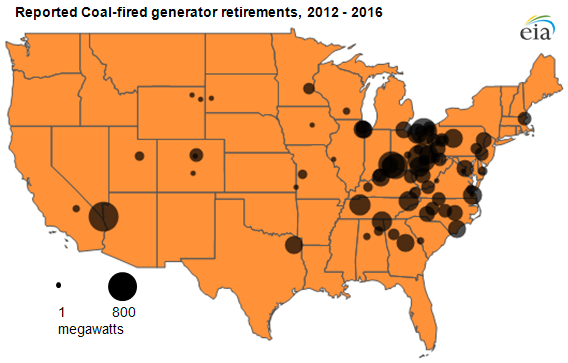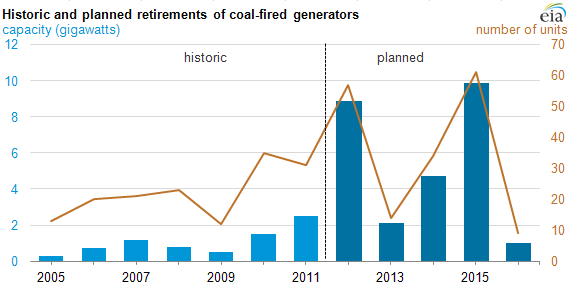The Energy Information Administration (EIA) recently announced that coal plant owners and operators expect to retire about 27 gigawatts of coal-fired capacity by 2016 — four times the 6.5 gigawatts of capacity retired between 2007 and 2011. In 2012, electric generators are expected to retire 9 gigawatts of coal-fired capacity, the largest amount of retirements in a single year in America’s history.
In 2011, there were 1,387 coal-fired generators in the United States, totaling almost 318 gigawatts. The 27 gigawatts of retiring capacity is 8.5 percent of total coal-fired capacity. The 2012 record retirements are expected to be exceeded in 2015 when nearly 10 gigawatts of coal-fired capacity are expected to retire. [i]
Most of the units retiring are located in the Mid-Atlantic, Ohio River Valley, and Southeastern United States as shown in the map below.
Source: U.S. Energy Information Administration, http://www.eia.gov/todayinenergy/detail.cfm?id=7290
Note: Capacity values represent net summer capacity.
Source: U.S. Energy Information Administration, http://www.eia.gov/todayinenergy/detail.cfm?id=7290 Note: Data for 2005 through 2011 represent actual retirements. Data for 2012 through 2016 represent planned retirements, as reported to EIA. Data for 2011 through 2016 are early-release data and not fully vetted. Capacity values represent net summer capacity.
The EIA provides several reasons for the retirements, but the largest factor affecting coal-fired generating units are new regulations recently imposed by the Environmental Protection Agency (EPA). For example, the Mercury and Air Toxics Standards require the addition of costly environmental equipment, which will result in the retirement of the older, smaller units that are not used heavily because it is not cost effective to make the additional investment.
However, the table below shows that the coal-fired generators that are planned for retirement between 2012 and 2015 have an average size of 154 megawatts (MW)—more than twice the average size of the units retired during the 2009 to 2011 period, which had an average size of 59 megawatts. Twelve units of at least 200 megawatts are expected to retire in 2012, including two large 790 megawatt units. Another 13 coal-fired units with generating capacities of 200 megawatts or greater are expected to retire in 2015, which is close to the average size of all coal-fired units existing in 2011 (228 megawatts).
Source: U.S. Energy Information Administration, http://www.eia.gov/todayinenergy/detail.cfm?id=7290
Note: Data for 2009 through 2011 represent actual retirements. Data for 2012 through 2015 represent planned retirements, as reported to EIA. Data for 2011 through 2015 are early-release data and not fully vetted. Capacity values represent net summer capacity.
The table also shows that the plants that are planned for retirement are also more efficient than previously-retired plants. By 2015, the retiring coal-fired units will have average tested heat rates of about 10,700 British thermal units per kilowatt hour, which are about 12 percent more efficient, on average, than those units that retired during 2009 to 2011. But, they are about 5 percent less efficient than the average coal unit.
Other factors that EIA identifies for the record retirements of coal-fired units are the low price of natural gas due to the boom in shale gas production resulting from hydraulic fracturing technology; modest electricity demand growth that has led to less use of smaller, older, and less efficient plants; the availability of natural gas-fired combined cycle units that are not currently fully utilized; and the cost of complying with state laws and regulations that result in other mandatory investments, such as the Renewable Portfolio Standards which many states have that require investments in qualified renewable generating technologies.
Reliability of the Generating Grid
The question, of course, is whether these retirements are a detriment to the reliability and security of our national generating grid? The North American Electric Reliability Corporation’s (NERC) most recent long-term assessment found that existing and proposed environmental regulations affecting fossil fuel plants in the United States may significantly affect bulk power system reliability.
NERC, the nation’s leading authority on electric reliability, evaluated four major regulations now being proposed or implemented by the Environmental Protection Agency and found them to expose the United States to significant energy vulnerabilities. NERC estimates that nearly a quarter of our coal-fired capacity could be off-line by 2018 and that as many as 677 coal-fired units (258 gigawatts) would need to be temporarily shut down to install EPA-mandated equipment.[ii] These EPA regulations must be implemented within a 3-year window and the mandated equipment takes about 18 months to install. Because EPA’s three year timeline is so tight and the regulations affect so many units, utility companies are not sure that they can meet the standards and ensure reliability of the electricity system at the same time.
While we are shuttering our coal-fired power plants, other countries are turning to coal for generating electricity. According to China’s National Bureau of Statistics, China’s coal consumption increased 9.7 percent in 2011 to a record 3.7 billion tons, more than 3.5 times the coal consumption of the United States. China is supplying over 70 percent of its electricity with coal. In India, coal provides 55 percent of its electricity. And, Germany is generating about 25 percent of its electricity from coal, having increased coal consumption by 3.3 percent last year. The power gap in Germany, created by the shutdown of eight nuclear power stations, is largely being filled by lignite coal.[iii]
Conclusion
While other countries are turning to coal as a major source of generation, the United States is shuttering coal-fired plants in record numbers, mainly due to environmental regulations imposed by the federal government. This is curious since the United States has the largest coal reserves in the world. NERC has found that these regulations may cause significant vulnerabilities to the reliability of our generating grid. While natural gas remains abundant and inexpensive, it is making the transition away from coal relatively easy. However, once natural gas prices rise, consumers will be confronted with higher electricity prices and will no longer have an inventory of coal-fired plants to provide inexpensive electricity.
[i] Energy Information Administration, 27 gigawatts of coal-fired capacity to retire over next five years, http://www.eia.gov/todayinenergy/detail.cfm?id=7290
[ii] North American Electric Reliability Corporation, 2011 Long Term Reliability Assessment, November 2011, http://www.nerc.com/files/2011LTRA_Final.pdf
[iii] Institute for Energy Research, https://www.instituteforenergyresearch.org/2012/04/26/the-dwindling-share-of-coal-what-does-it-mean/






